The laziest part of summer, temperatures are at their peak and I just feel like dozing. In the garden it is a quite time, many plant are going into their decline after blooming earlier the season. With the heat many plants will droop, some will become completely dormant and start loosing their leaves. Others now will shine and come into their season of glory while showing how resilient they are and carry on as if nothing is happening. The Matilija Poppy, California Tree Poppy (Romneya coulteri) acts like it is just another day at the office and look beautiful and refreshing as ever.
Romneya coulteri is found in southern California ranging through the Santa Monica to the Santa Ana Mountains near San Diego and then into Baja in Mexico. They are normally found growing in dry washes and canyon and gulleys where the conditions are very dry and the soil tends to be poor. The southern plants are classified as Romneya trichocalyx or BristlyMatilija Poppy. there are also hybrids which are known and are in cultivation. For the common gardener like you or I we can safely consider them to be one plant type as all forms look and grow exactly the same.

Part of the charm of Romneya coulteri are the petals which bring to mind the most delicate silk or crepe paper.
Romneya coulteri was first brought into the garden by Dr. Thomas Coulter(1793-1843). He was a botanist and explorer who served in Mexico. While he was there he managed silver and lead mines in the late 1820s to early 1830s. In his spare time he would explore the area. He had the foresight to envision that great cities would one day be established there. When he returned home to Ireland in 1834 he brought with him a collection of dried plant materials, insects and rock samples. He later became curator of the herbarium at Trinity College, Dublin. Here his plant samples were studied and included in the national collection which is now part of the National Botanical Gardens of Ireland at Glasnevin.

A large suckering clump of Romneya coulteri or California Tree Poppy is found in the White Garden at Government House.
It was at Glasnevin that Romneya coulteri was first grown in a garden setting in 1875. The delay introducing is likely partly due to getting viable seed to germinate as well propagating it which is difficult. Romneya comes from honoring Thomas Romney Robinson(1792-1882) an important Irish astronomer. Coulteri is named for Dr. Coulter who is mentioned above. The name was chosen by William Harvey in 1845 to honor the two men who were his contemporaries and friends in Ireland.
Even though Romneya coulteri comes from sunny California it grows very well in many other places which are not so warm or sunny. Here in the north(wet)west it is an increasingly common sight in larger gardens. people have come to appreciate its long blooming, drought tolerant qualities. Another thing that is loved is the beautiful grey green foliage which works so well with many other colors. The blooms also have a light delicate fragrance which is much-loved.
Like all members of the poppy family care must be taken when placing Romneya coulteri in the garden. This not a small plant, in fact it can grow to nearly 3m(10ft) tall and nearly as wide, this is why this plant is often thought of as more of a shrub than a woody based perennial. California Tree Poppies spread by underground rhizomes which can go under paths, driveways and even houses and pop out on the other side. Here they generally grow 2m(6ft) tall or less. Choose a site which will give them the space they need and will not impact other more delicate or less vigorous plantings. these plants are not fussy about their site as long as it is well-drained, soil can be poor or rich, no amendments or fertilizer should be given. When first planting they need water about once a week and then in following years should be left alone.
Romneya coulteri plants have stiff woody stems which grow best with scant water and full sun and less likely to flop. This stately plant works well in the back of borders or the very center of large beds where it can support other plants leaning and climbing up its mighty stems. It is great in dry areas or those which will naturally have less pampering. It attract butterflies, bees and other insects. It would be useful in mass plantings or even as a very coarse tough groundcover for dry neglected areas. In warmer areas it is almost evergreen, here it is often treated as other perennials and cut down in the fall when it goes dormant. It is rated as zone 6(-10f) by some authorities and zone 8(-12c or 10f) by others. I think must be related to the winter dampness and drainage. Propagation is best done with young root cuttings.
The sap of Matilija Poppies was in the past medicinally for skin and gum problems and for stomach upsets. There is a charming legend relating to the flower which claims the petals of the flower were believed to have been made of the soul of a heart-broken maiden who died. The Chumash (native people of the area which this plant grows) gods changed her into the pure white petals.
Trails Stemming From Tall Poppies:
Detailed description of the plant and where it lives: http://www.calflora.net/bloomingplants/matilijapoppy.html
Growing Romneya here in the northwest: http://www.rainyside.com/features/plant_gallery/perennials/Romneya_coulteri.html
Glasnevin Botanical Garden of Ireland: http://www.botanicgardens.ie/
Romneyas are now considered a rare and threatened plant in California: http://cnps.site.aplus.net/cgi-bin/inv/inventory.cgi/Go?_id=romneya_coulteri&sort=DEFAULT&search=Romneya%20coulteri





 Stumble It!
Stumble It!






